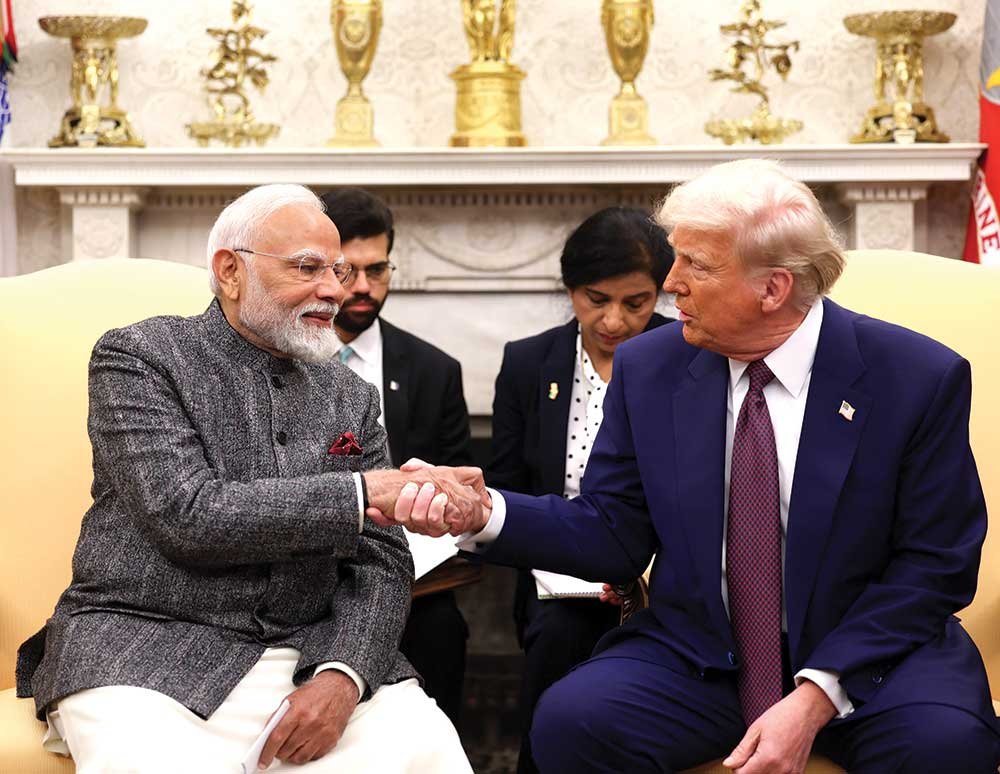Donald Trump’s recent announcement of reciprocal tariffs marks a significant shift in global trade dynamics, emphasising his administration’s focus on addressing the so called ‘trade imbalances’ which according to him has till now put America in the losing position.
Under President Donald Trump’s ‘The Fair and Reciprocal Trade Plan’, the United States will impose tariffs equivalent to those levied by other countries on American goods. This move, intended to protect American industries and reduce the US trade deficit while positioning US as a manufacturing powerhouse has sparked concerns of a global trade war, with widespread economic consequences for both developed and emerging economies.
Possible Impact on Emerging Economies and India
Emerging economies, particularly in South Asia, Latin America, and Africa, are expected to bear the brunt of these tariffs. Historically, these countries have relied on high import duties to shield nascent industries from foreign competition.
The abrupt shift in US policy could disrupt these protectionist measures, making it difficult for domestic businesses in these regions to compete effectively. Countries like India, which has traditionally imposed high tariffs on agricultural and industrial products, may face retaliatory measures that could impact key sectors such as manufacturing, pharmaceuticals, and technology.
As a major trading partner of the US, India’s exports of textiles, information technology services, and automotive parts could suffer under the new tariff regime, thereby affecting employment and economic growth. Moreover, Indian companies that rely on cost-effective imports from countries with lower tariff structures may face increased input costs, reducing their global competitiveness.
Despite the negatives, India is also in a better position to ward of the tariff fears and convert the problems into opportunities. This is because India is now in position as a sweet spot like never before, with lesser tariff imposed on it then its primary export competitors like China, Vietnam and Cambodia reeling under the Trump’s tariff hammer.
Emerging economies, particularly in South Asia, Latin America, and Africa, are expected to bear the brunt of these tariffs. Historically, these countries have relied on high import duties to shield nascent industries from foreign competition. The abrupt shift in US policy could disrupt these protectionist measures, making it difficult for domestic businesses in these regions to compete effectively
Sector-Wise Ramifications
The impact of these tariffs extends beyond individual countries to entire sectors. The steel and aluminium based industries are directly affected, as the United States has increased duties on these commodities.
Countries like Canada, Mexico, and Brazil, which export large volumes of these materials to the US, will have to seek alternative markets or face economic slowdowns.
Similarly, the automobile sector is set to be significantly disrupted. The newly imposed 25% tariff on imported vehicles and motorbikes will hurt countries like Germany, Japan, and India, which export cars to the US.
In response, these nations may introduce countermeasures much like that of China’s, leading to increased prices for automobiles and reduced global sales. India, which has been increasing its automobile exports to the US, may see a significant setback, especially in segments like electric vehicles and auto components.
Another critical sector that could have felt the effects of these tariffs is pharmaceuticals. The US has traditionally maintained minimal tariffs on medicines and pharmaceutical ingredients. But thankfully the US has desisted from putting any tariffs in the sector as it understands the critical nature of the sector and importance of low-cost medicine to its own citizens and its health sector, incidentally this sector is a major contributor (approximately $9 billion) to India’s US exports.
The impact of these tariffs extends beyond individual countries to entire sectors. The steel and aluminium industries, for instance, are directly affected, as the US has increased duties on these commodities
Agriculture and Trade Barriers
Agriculture is another sector that is likely to see significant repercussions. Many emerging economies impose high tariffs on agricultural imports to protect domestic farmers. In response to the US’s reciprocal tariff policy, nations like India, China, and Japan may face higher levies on their agricultural exports.
This could reduce their competitiveness in the US market, impacting farmers and food industries in these countries. Additionally, American agricultural exports, which traditionally benefited from low tariffs, may face new barriers in global markets, exacerbating financial pressures on US farmers.
In India, where agriculture is a crucial sector employing nearly half of the population, any decline in exports of commodities like rice, spices, and tea to the US could negatively impact rural economies. India needs to stay firm in its decision not to reduce agricultural subsidies come what may.
Broader Economic Implications and India’s Position
Beyond specific sectors, the overall economic impact of Trump’s tariff policies raises concerns about global economic stability. Economists argue that increased tariffs could slow down international trade, reduce investment flows, and even contribute to global inflation. Supply chains that rely on seamless cross-border transactions could be disrupted, increasing costs for businesses and consumers alike.
Furthermore, as trade tensions escalate, the risk of a full-scale trade war looms, potentially triggering a global economic slowdown. For India, this situation presents both challenges and opportunities.
While certain sectors may struggle, India’s growing domestic market could help cushion some of the external shocks. Moreover, India could use this opportunity to strengthen trade relations with other nations, positioning itself as an alternative supplier to markets that might shift away from the US.
The imposition of new duties will not only impact American pharmaceutical imports but also hurt global supply chains, particularly affecting India, which is a major supplier of generic medicines to the US. India’s pharmaceutical industry, which contributes significantly to its GDP and employment, could experience reduced demand, leading to job losses and lower profit margins
Additionally, deft trade negotiations could position India as a potential buyer to American crude which is already reeling under severe impact due to the fears of looming economic slowdown. This will reduce trade deficit between both nations while broadening our oil basket with cheaper crude supplies with reduced blackmailing.
The Way Around: Strategic Adjustments for India
India must respond proactively to the changing trade landscape by adopting a diversified approach. Strengthening domestic manufacturing and reducing dependence on imports will be crucial for maintaining economic stability. The Indian government could consider policy measures such as tax incentives for domestic producers, easing trade agreements with other nations, and investing in technological advancements to boost industrial efficiency.
Furthermore, India could explore closer trade partnerships with the European Union, ASEAN countries, and Africa to offset potential losses from the US market. With news emerging of China willing to provide unhindered access to sell its goods for Indian companies and vice-versa it is expected that agreements on similar lines with other countries and trading blocs may happen sooner than later.
A well-structured export strategy focusing on emerging markets could help Indian businesses sustain growth despite increasing trade barriers, rather leverage the crisis as an opportunity.
Sector-Wise Impact Overview
The upcoming 26% US tariffs imposed on India presents a mixed picture for Indian exports. While the textile sector, with $10 billion in exports, faces pressure, it retains a competitive edge over peers like Vietnam, Cambodia, China and Bangladesh, who face steeper duties of as high as 48%.

Electronics, valued at $14 billion, is among the hardest hit, though semiconductors—a strategic sub-sector—have been wisely exempted. Notably, India’s pharmaceutical sector has emerged as a clear winner, with generics—accounting for 30% of India’s total pharma exports—explicitly excluded from the new tariff list.
This not only reinforces the sector’s strategic importance to the US healthcare system but also provides Indian drug manufacturers with critical breathing room amid global trade turbulence.
Beyond specific sectors, the overall economic impact of Trump’s tariff policies raises concerns about global economic stability. Economists argue that increased tariffs could slow down international trade, reduce investment flows, and even contribute to global inflation
Agriculture sees a nuanced impact: though items like shrimp and rice now face tariffs, India’s position remains relatively strong compared to countries with harsher levies as in the case of Cambodia, Vietnam, China, Bangladesh etc.
In contrast, the gems and jewellery sector could suffer due to its price sensitivity and labour costs. Automobiles remain under older 25% duties but are spared from the new hike. Overall, India’s tariff position—lower than China but higher than Japan—offers both risk and opportunity, with pharma standing out as a stabilising force.
Strategic policy support and nimble supply chains will be key to navigating this new landscape and converting the problem areas into opportunities.
Uncertainty in Global Trade
Essentially, while Trump’s reciprocal tariff policy is designed to reduce trade imbalances and strengthen domestic industries, its wider implications could be detrimental to global economic stability.
Emerging economies, in particular, face heightened risks, with key sectors such as manufacturing and agriculture poised for significant disruptions. As nations retaliate and global trade networks adjust, the long-term consequences of these tariffs will be closely watched.
India, as a major global player, must navigate these uncertainties by adapting its trade policies, enhancing domestic production, and diversifying its export markets and positioning itself as a viable manufacturing hub better than its competitors like Vietnam, Cambodia, and China.
India could explore closer trade partnerships with the European Union, ASEAN countries, and Africa to offset potential losses from the US market. A well-structured export strategy focussing on emerging markets could help Indian businesses sustain growth despite increasing trade barriers
The higher rate of tariff imposed on these countries helps India gain traction in the long-run due to its competitive tariff positioning and assisting the US companies’ withdrawal from these markets and gravitation towards India.
The forthcoming Indian trade discussions will play a pivotal role in mitigating the risks and setting up a benchmark in terms of negotiations for India in its own interest. Clearly, a message from the PMO underlines the seriousness of the topic with high chances of various critical sectors including agricultural subsidies to be kept under a ‘Non-negotiable’ list.
The US has played its card and it is India’s turn to play its ‘Trump Card’ well. The future of international trade remains uncertain and gloomy but the current stalemate may help India to rise as an export centred economic superpower.
Chirayu Sharma is an MBA working as a finance professional and research analyst. He contributes insightful opinions on a diverse range of topics to various journals.
Dr Punit Saurabh, teaches strategy and international relations at the Institute of Management, Nirma University, Gujarat. The views expressed are of the writers and do not necessarily reflect that of Raksha Anirveda
The writer is an MBA in Finance, the writer is a SEBI-registered NISM-certified Research Analyst. He has authored over nine articles published in various magazines and journals focusing on finance, defence, and strategic insights. His work reflects a commitment to delivering in-depth analysis and raising awareness in these critical domains.

















